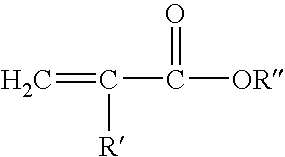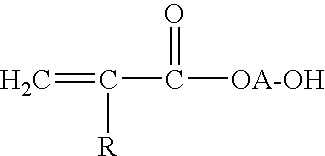Method of Modifying Materials Surfaces
a technology of materials surface and grafting density, which is applied in the direction of dental prosthesis, dentistry preparation, pharmaceutical non-active ingredients, etc., can solve the problems of less controllable grafting density at the material surface, limited thickness, and low grafting density of the brush, and achieves experimentally much more difficult “grafting to” procedures
- Summary
- Abstract
- Description
- Claims
- Application Information
AI Technical Summary
Benefits of technology
Problems solved by technology
Method used
Image
Examples
example 1
[0128]In this experiment, a method of modifying a glass surface by covalent bonding thereto of, subsequently, an aminopropyltriethoxysilane linker, a polyacrylic acid pre-coat polymer and an octadecylamine brush polymer is described.
[0129]The pre-cleaned glass substrates were submerged in a fresh coating solution of 5% 3-aminopropyltriethoxysilane in H2O and sonicated for 20 min in an ultrasonic bath. The substrates were thoroughly washed (3×) with water followed by drying for 1 hr in an oven at 80° C. The thus functionalized substrates were dipped in a solution of polyacrylic acid (Mw 100,000) in water (1 wt %) and dried in an oven at 100° C. under reduced pressure (<100 mbar) for 4 hours. The substrates were thoroughly washed (3×) with chloroform to remove the non-attached polyacrylic acid. The substrate was covered with 1-octadecylamine (C18; Tm 52° C.) and placed in an oven under reduced pressure (80° C., 300 mbar) for 4 hours. The excess brush polymer was removed by washing the...
example 2
[0131]Using the same conditions as described in Example 1, a polypropylene chemical film having a thickness 22 μm (such as generally available from any supplier, e.g. from the Dow Chemical Company or from Goodfellow Cambridge Ltd., Huntingdon, UK) was first activated by corona treatment by using standard equipment comprising a high voltage (15,000-20,000 V) generator. The surface modification of the substrate showed an increase of the water contact angle indicating a modification of the surface. Surface modifications such as the present corona treatment are well within reach of the skilled person, and the level of modification can easily be selected for optimal bonding of the pre-coat layer.
[0132]The samples were subsequently functionalized with 3-aminopropyltriethoxysilane and further treated as described in Example 1.
[0133]Contact angle measurements of water on the brush showed an increase of contact angle to 115 degrees.
example 3
[0134]Using the same conditions as described in Example 1, a polyterafluorethylene (Teflon®) surface was first activated by dipping the material in a KOH solution (20 wt %) for 2 minutes at elevated temperature (50 degrees C.) for 10 minutes followed by a functionalized with 3-aminopropyltriethoxysilane and further treated as described in Example 1.
[0135]Contact angle measurements of water on the brush showed an increase of contact angle to 105 degrees.
PUM
| Property | Measurement | Unit |
|---|---|---|
| Density | aaaaa | aaaaa |
| Polymeric | aaaaa | aaaaa |
| Biodegradability | aaaaa | aaaaa |
Abstract
Description
Claims
Application Information
 Login to View More
Login to View More - R&D
- Intellectual Property
- Life Sciences
- Materials
- Tech Scout
- Unparalleled Data Quality
- Higher Quality Content
- 60% Fewer Hallucinations
Browse by: Latest US Patents, China's latest patents, Technical Efficacy Thesaurus, Application Domain, Technology Topic, Popular Technical Reports.
© 2025 PatSnap. All rights reserved.Legal|Privacy policy|Modern Slavery Act Transparency Statement|Sitemap|About US| Contact US: help@patsnap.com


